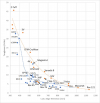I'm a big fan of Civivi and it's became my go to brand. They offer some of the best bangs for your buck, especially when you consider all the designers involved. With that, I just have a couple questions that maybe someone could answer besides the headline of this thread. Civivi has seemed to have ditched D2 steel, which was probably the best choice for me overall. I live in Michigan and have never had a D2 knife rust as of yet.
From my understanding, D2 has the best edge retention of any budget steel, which I prefer, but Civivi seems to mainly be using 14C and Nitro-V. Which of these has better edge retention? I also have a Civivi Sokoke on the way in Damascus. Does anybody know if Civivi is still using their 9CR for the Damascus base or have they switched to something else? Lastly, what is your favorite Civivi Steel and why? Thanks
From my understanding, D2 has the best edge retention of any budget steel, which I prefer, but Civivi seems to mainly be using 14C and Nitro-V. Which of these has better edge retention? I also have a Civivi Sokoke on the way in Damascus. Does anybody know if Civivi is still using their 9CR for the Damascus base or have they switched to something else? Lastly, what is your favorite Civivi Steel and why? Thanks

